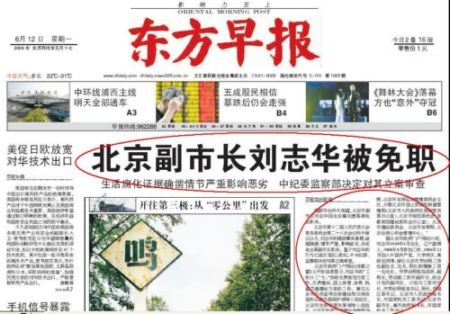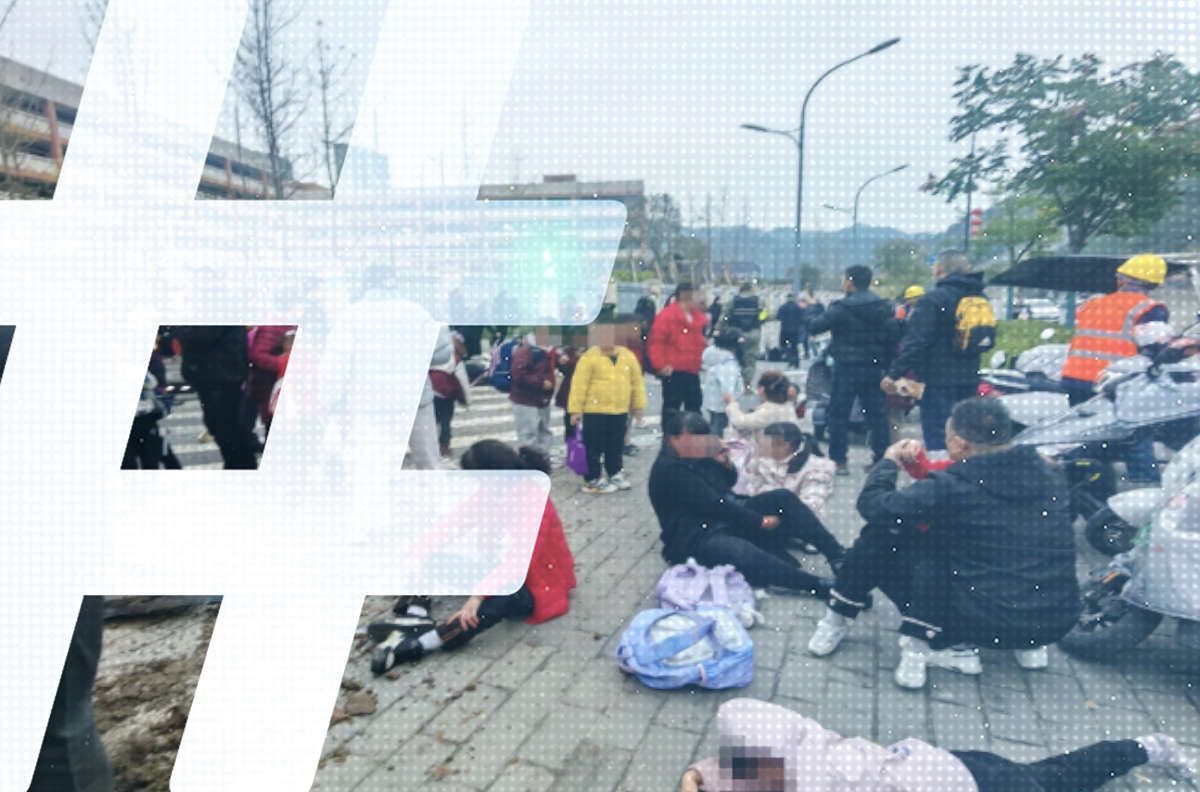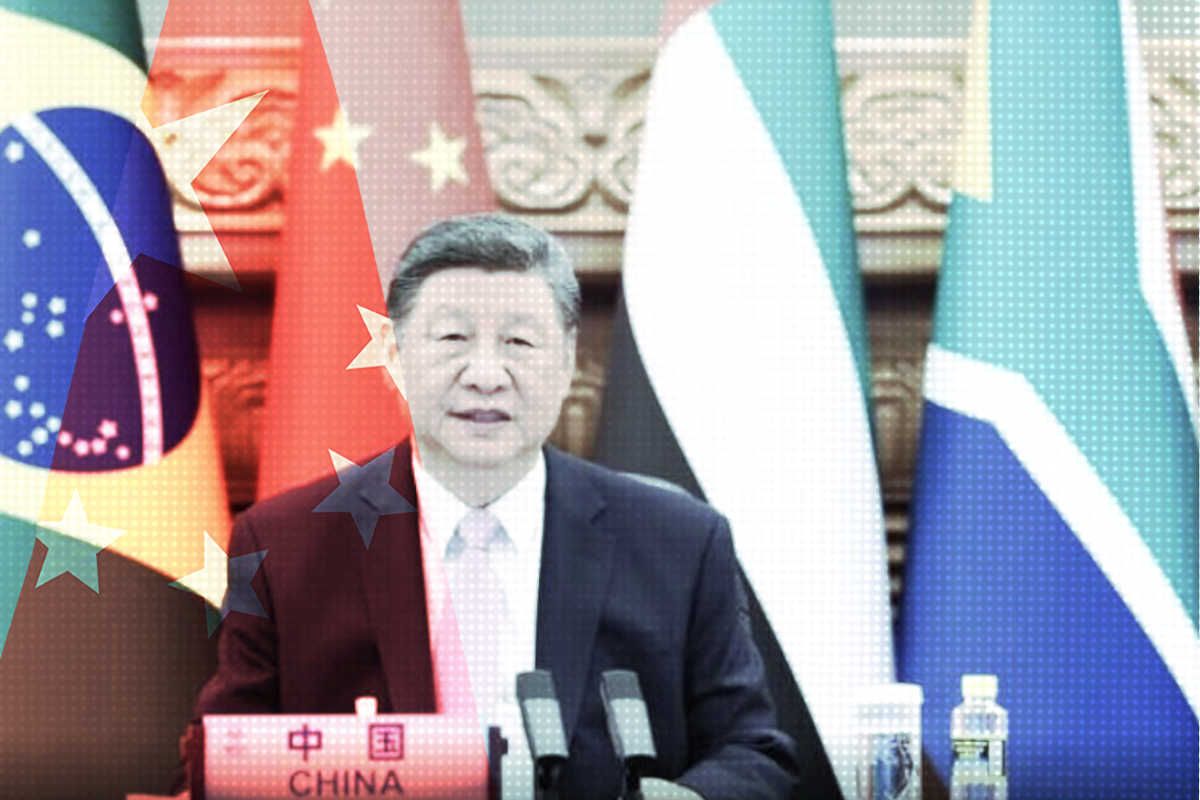Headlines and Hashtags
The Liu Zhihua Case: reading power and profit through the Chinese newspaper page
As details continue to emerge in the corruption case surrounding Beijing’s former vice-mayor, Liu Zhihua, with news that Beijing Capital Land chairman Liu Xiaoguang (刘晓光) has now been arrested on possibly related charges (as reported in Chinese media Monday, Hong Kong’s Wen Wei Po and Singtao News yesterday, and the South China Morning Post today), it’s a good time to re-visit early Chinese coverage of the case (the first Liu), which is one of the clearest examples of power and commercialization at play in Chinese journalism.
Chinese media were working under a ban on reportage – that is, they could use the official Xinhua News Agency release, but could not dispatch reporters, conduct interviews, etcetera. So what did coverage look like for newspaper readers on June 12?
Here is People’s Daily, the official mouthpiece of the central party committee. As a national Party newspaper, People’s Daily was not concerned with protecting Beijing city officials. But they did not want to call too much attention to story, which raises questions about misuse of funds for the 2008 Olympic Games. A very small article using the Xinhua release appears on page four, just above the weather report. Here, in fact, is where you typically find many of the really important stories in China:

The headline for the story actually emphasizes not Liu Zhihua’s arrest but the meeting of party officials. The decision to remove Liu actually came out of that meeting.
Beijing Daily, the mouthpiece of Beijing’s municipal party committee, has a vested interest in protecting city leaders. Not surprisingly, the coverage is strictly downplayed. The story is buried at the bottom of page one. The leading stories are about a new policy statement on improving skilled labor, and creating signature sites in Beijing to attract tourism. The story directly above the Liu Zhihua item is a grandiloquent policy statement about the need to fight corruption.

Next, we turn to Beijing Youth Daily, a newspaper published by the Beijing chapter of the Communist Youth League, a national organization for Communist Party recruitment. Because the paper falls under the auspices of Beijing city leadership, the coverage is similar to that of Beijing Daily. There are slight differences, but the biggest ones concern the overall commercial look of the paper and not the placing of the Liu Zhihua story. Commercial considerations carry the story to the front page, where it joins safer stories of “relevance” to the people, about a “Domino Olympics” and emergency exit plans for a Beijing subway station.

The headline and use of the Xinhua release in the Beijing Youth Daily story are identical.
Now for Beijing Evening News, a commercial spin-off of Beijing Daily, the city-level mouthpiece we discussed earlier. The content is unchanged, but the positioning is more prominent. The subhead about the removal of Liu Zhihua might capture some attention at newsstands and drive the desired spike in circulation.

But the top stories in Beijing Evening News are about a new Aids drug (with photo at center) and a drunk-driving case (across the top). Coverage of the World Cup runs along the right margin.
Moving again up the administrative ladder national party papers with a commercial interest in the Liu Zhihua story, the differences are more pronounced. The image below is the cover of Jinghua Times, a commercial spin-off of the official mouthpiece, People’s Daily, that started off the analysis. Jinghua Times has a definite commercial interest in the story about Liu Zhihua – it can “attract eyeballs”, as they say in today’s Chinese media industry. At the same time, it doesn’t need to step carefully around top Beijing city leaders. However, the ban on reportage is national (the central government is worried about fallout for the Olympic Games), so there is no additional news material. The answer is a massive headline under the banner that directly pronounces Liu Zhihua’s removal from office. Readers are then referred to the story on the inside pages, where they will find the Xinhua news release.

Moving on to other cities in China the differences are also clear. The following is from the Oriental Morning Post, a commercial newspaper in Shanghai published by the official Wen Hui Bao. Like Jinghua Times, and out of the same commercial considerations, they run a huge headline about Liu’s removal on the front page. The article below the headline, however, is much longer than the Xinhua news release. How is this possible given the ban? The newspaper simply searched a Beijing government website for public information about Liu Zhihua. The information available, which no-one had apparently thought to remove, clearly spoke to Liu’s position within the city’s leadership at a time when other Beijing leaders were trying frantically to distance themselves.

[Posted by David Bandurski and Brian Chan, June 21, 2006, 3:13pm]




















